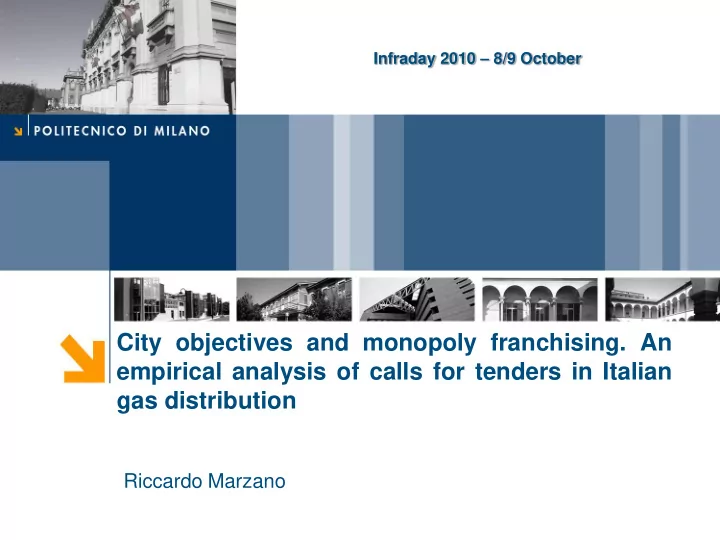

Infraday 2010 – 8/9 October City objectives and monopoly franchising. An empirical analysis of calls for tenders in Italian gas distribution Riccardo Marzano
Outline 2 • Introduction • Gas distribution in Italy • Background • Data and variables • The model • Results • Conclusions
Introduction 3 • Aims of the paper Objectives pursued by Italian municipalities in franchising the gas distribution service Testing the taxation by regulation effect (Posner, 1971-1972) • Empirical analysis on a sample of 174 calls for tenders (2001-2008 period) • Empirical methodology: Linear simultaneous equations model 3SLS estimation
Gas distribution in Italy (1/2) 4 • Legislative Decree n. 164/2000 (Letta’s Decree) compulsory competitive bidding procedures in selecting utility management units, designed by local governments, which are entrusted with functions of programming and control definition of an upper bound to the franchise duration (12 years) price (tariffs) regulation entrusted to the AEEG, the Italian energy regulator property of infrastructures going back to the local authority at the end of the franchising term
Gas distribution in Italy (2/2) 5 • “Most economically advantageous tender” approach Upper bounds on the scores • Scoring rules Formulas to compute each score • Example Three dimensional scoring (Scores A B C) Upper bound on score A = 50 A i = [bid i (A)/bid max (A)]*50 Upper bound on score B = 30 B i = [bid i (B)/bid max (B)]*30 Upper bound on score C = 20 C i = [bid i (C)/bid max (C)]*20 Total Score i = A i + B i + C i
Background 6 • Monopoly franchising Seminal idea: Demsetz (1968) • Critics on competitive franchising arrangement Transaction costs: Williamson (1976), Goldberg (1976) Taxation by regulation: Posner (1771-1972), Prager (1989), Beutel (1990), Otsuka & Braun (2002) • Scoring Auctions Theoretical analyses: Asker & Cantillon (2008-2010)
Data and variables (1/2) 7 • Sample 174 calls for tenders spanning from 2001 to 2008 Region 2001 2002 2003 2004 2005 2006 2007 2008 Tot Abruzzi 3 6 1 1 11 Aosta V. 1 1 Apulia 2 2 Basilicata 3 2 1 2 8 Calabria 1 1 1 3 Campani 1 5 2 3 1 1 2 15 a Emilia R. 1 1 Friuli V.G. 1 1 Lazio 1 4 2 1 1 1 10 Liguria 2 2 Lombardy 4 6 6 15 7 7 11 56 Marche 1 1 2 Molise 2 1 1 4 Piedmont 1 3 1 1 1 1 8 Sardinia 1 2 13 16 Sicily 2 2 2 1 7 Tuscany 1 1 2 Veneto 1 4 4 5 6 5 25 Total 1 6 26 26 37 20 22 36 174
Data and variables (2/2) 8 • Score variables Fee (upper bound on franchise fee score) Trans (upper bound on terms for infrastructure transfer score) Prices (upper bound on prices score) Infra (upper bound on new infrastructure asset score) Serv (upper bound on service quality and organization score) • City characteristics variables FinAut (Financial Autonomy) Debt (Level of obligations) Liq (Liquidity indicator) qProceeds (Quality of proceeds) Turnover (Political turnover indicator) Exp (Experience of bureaucrats) Size (size of the city) S (Localization dummy) Poverty (Poverty indicator) PubNet (Public network) Constr (Construction dummy)
The model 9 • Linear simultaneous equations model: 5 ln Sc ln Sc FinAut Debt Liq q Pr oceeds Turnover Exp Size u 1 10 1 i i 11 12 13 14 15 16 17 1 i 1 i 1 5 ln Sc ln Sc Constr Debt Liq PubNet Turnover Exp Size u 2 20 2 i i 21 22 23 24 25 26 27 2 i 1 i 2 5 ln Sc ln Sc Poverty Turnover Exp Size u 3 30 3 i i 31 35 36 37 3 i 1 i 3 5 ln Sc ln Sc Constr S Turnover Exp Size u 4 40 4 i i 41 42 45 46 47 4 i 1 i 4 5 ln Sc ln Sc Turnover Exp Size u 5 50 5 i i 55 56 57 5 i 1 i 5
Results – First equation only (Franchise fee) 10 (eq by eq IV) (3SLS) -77.6800 1654.10** Debt (-0.06) (2.00) -4.70100 100.400** Liq (-0.06) (2.00) -0.64200 13.630** FinAut (-0.06) (1.98) 0.00130 -0.03140* qProceeds (0.03) (-1.87) 0.84200 -17.2500* Exp (0.06) (-1.95) -1.49600 31.1200** Turnover (-0.06) (2.08) -0.00024 0.00495** Size (-0.06) (2.04) Note : standard errors in parentheses. ***, ** and * indicate, respectively, significance levels of <1%, <5% and <10%.
Conclusions 11 • Weak evidence for taxation by regulation effect • No evidence about some other aspects influencing competitive procedure designing • Difficulties in capturing other relevant aspects because of no availability of data
12 Thank you for your attention!
Recommend
More recommend